by Rick Landers.
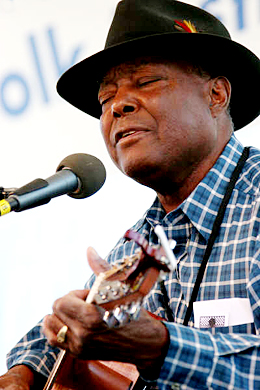 |
|
“Bowling Green” John Cephas. Photo by Michael G. Stewart. |
“Bowling Green” John Cephas, who takes his stage name from Bowling Green, Virginia, where he was raised, embodies the soul and spirit of a little-known style of music called the Piedmont blues. Guitar International spoke with Cephas at the 69th National Folk Festival in Richmond, Virginia, on September 14, 2007, before he went on stage with master harmonica player Phil Wiggins, about his style of blues, his guitars and his life-long study and commitment to keeping the Piedmont blues alive.
Cephas was exposed to the primitive style of blues by his aunt and learned the thumb-and-fingerstyle guitar picking techniques from his cousin. He gathered up a song list comprised of work by such traditional blues men as Blind Boy Fuller, Tampa Red, Blind Lemon Jefferson and the Reverend Gary Davis and was playing for his family and neighbors when he was nine years old.
He jumped on the gospel circuit with the Capitol Harmonizers before he served a hitch with the Army durng the Korean War. A decade later Cephas found his way to small clubs and other venues where he made a living playing the music that he grew up with and loved, a traditional style of blues named after an area between the Appalachian Mountains to the west and coastal plain to the east, stretching as far south as Georgia and up to Washington, D.C.
By 1977, John joined master harmonica player Phil Wiggins to form a long partnership that has lasted to this day. Cephas and Wiggins have shared the stage at folk festivals around the world and both have a sense of responsibility to pass to the next generation the love and appreciation they have for traditional music.
Cephas formed the Washington, D.C. Blues Society during the 1980s and has served as an Executive Committee member for the National Council for the Traditional Arts. In 1989 the National Endowment for the Arts bestowed upon him a coveted National Heritage Fellowship that is presented to individuals who have dedicated themselves to the preservation of the traditional arts in music, dance and crafts.
Most people have heard of Memphis, Chicago, and Delta blues, but Piedmont blues seems to be a somewhat obscure style. How do you describe the Piedmont blues and can you tell us something about its history?
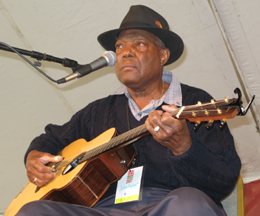 |
|
“Bowling Green” John Cephas. Photo by Rick Landers. |
John Cephas: The Piedmont blues is what you call basically an alternating thumb and finger picking technique that’s applied to the guitar. When you talk about the Piedmont technique it comes from a region in the United States that we call the Piedmont area. Say roughly from the mountains to the ocean on the Eastern part of the United States, Maryland, Virginia, North Carolina, and South Carolina is called the Piedmont.
So, in this area when they were creating the blues it was basically an alternate thumb and finger picking. This technique has its roots in Africa. The roots lie basically in the western parts of Africa in Senegal and Mali. If you are familiar with some of the kora players that play that African instrument, they use this same technique, but they did it with both hands because they didn’t have to fret it.
The kora is an instrument with 21 strings on it and they play it on both sides of the instrument, ten strings on one side of the instrument and eleven on the other side. They can make almost any chord, any note that I can do because they’ve got twenty-one strings and they don’t have to fret it. At the bottom part of the kora you play an alternate thumb and fingerpicking and that’s where the basic Piedmont style comes from.
As a traditional or roots music musician, do you consider your music to be stuck in the past or does it continue to evolve?
JC: No, it continues to evolve. Now, there are many musicians today that play many different forms of blues and some of the more modern forms of music. But almost all of it that you hear, if it’s blues related in any way, are from the two forms, Delta blues and the Piedmont blues. This is the grassroots of almost all of what you hear out there today. Even if you take some of the R&B, if you take the jazz, if you take the rock, the punk rock, funk rock all of the hip hop and all of that stuff, it has roots in the traditional music that was created in the black community.
This music will not die because there are so many people that are using some forms of it in some ways. And many presentations of more modern music, it’s still evolving. You know nothing stays the same. There’s always a change. There’s always an evolution. It takes a backseat to the more modern forms of music that you hear. That’s because it’s not presented. What people are more interested in is what is modern? What is today? What are they playing right now? What are the new creations of what was old?
But this music, like I said, is grass roots or blues related. It will not die because there are a lot of aspiring musicians that got their start doing this primitive or this traditional style of music and it evolves into more modern techniques and what have you. A lot of artists that you hear today that are very prominent they started off playing this basic traditional music and then they went to other forms of it. So it will still be here. It’s a beginning point.
Who are some of the great Piedmont blues players?
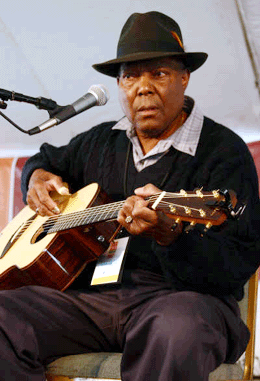 |
|
“Bowling Green” John Cephas. Photo by Michael G. Stewart. |
JC: Some of the individuals that were really instrumental who inspired people to make this kind of music would be Blind Boy Fuller, Reverend Gary Davis, Blind Blake, Pink Anderson and Brownie McGee. Those were probably the main thrust of Piedmont style musicians. And I think Reverend Gary Davis and Blind Boy Fuller were the most influential out of all the musicians.
Now there were many coming from North Carolina or from Virginia and South Carolina, but I think they were also inspired by Reverend Gary Davis and Blind Boy Fuller. And we also had Blind Lemon Jefferson who played that finger picking style. I think those were the most influential guys.
How did the idea germinate to establish the D.C. Blues Society and what part have you played from the beginning to today?
JC: You know that even when I was young I was interested in perpetuating the kind of music that I had learned. I wanted to teach it. I wanted to expose it to the public so they would be aware of the roots of this music. And I was inspired by this music. I wanted to learn to play this music and once I learned I wanted to share it with other people. And as far as the D.C. Blues Society is concerned this was one of my endeavors.
And this you may know, I’m the founder of the D.C. Blues Society and I wanted to inform people, to organize people, to present this music and also to give musicians a place to come where they could associate themselves and have opportunities to play clubs to get that general exposure. As you know blues societies have sprung up across the country and it benefits the public and the musicians. And that was the thought in my mind. So this is what inspired me to start the D.C. Blues Society in early to mid ‘80s, sometime in that era.
How did you and harmonica player Phil Wiggins meet?
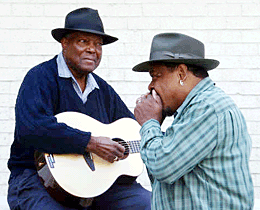 |
|
“Bowling Green” John Cephas and Phil Wiggins. Photo by Michael G. Stewart. |
JC: We met at the American Folk Life Festival in Washington, D.C. down on the Mall. That was my first time of my meeting Phil. Phil is a blues musician as well and I think he is motivated and he is inspired by the same things that motivated and inspired me. He loved the blues and he loved to play it. And even now he has the same interests as I do. He wants to present it and he wants to teach others.
So we met there on the Mall. I was playing with Big Chief Ellis and he was playing with Flora Molton. And just because we had common interests we kind of bonded ourselves together. Big Chief Ellis started a group called the Barrel House Rockers which we invited Phil to join in, which he did. And after Big Chief’’s demise, he passed away, then I played some by myself, solo ,and then I invited Phil to come on and we’ve been going as a duo since the ’70s and early ‘80s.
What types of instruments do you prefer?
JC: I like acoustic instruments. I was formally endorsing for Taylor guitars, a producer of many styles of acoustic instruments and they’re wonderful, wonderful instruments. At this time I’m endorsing for Baden guitars. T.J. Baden, it’s his company and his brand. He left Taylor and started his own company. He is formally the Senior Vice-President for Marketing and Sales at Taylor guitars that left Taylor Guitar Company and started his own company. And when he started the business he sent me one of his guitars. And I was so impressed with his guitar, all handmade guitars, wonderful tone, easy to play and what have you and so I am now endorsing for Baden Guitars. He’s in Escondido California,
Do you play slide?
JC: Yes, I can play slide. I play in open tuning. But that’s not the main thrust of my presentation. The main thrust is standard tuning and the repertoire of Mr. Skip James. I play Delta, Skip James style. But, I do play slide, but you know if I started playing slide I’d probably have to carry three or four guitars on the road and it’s easier just to carry two guitars. Sometimes I’ll use bottleneck but mostly if I’m going to play slide I’ll use metal.
Many traditional American roots music migrated here from Europe, the British Isles and Africa. Do you ever research the origins of the songs you play in order to get back to their roots?
CJ: Well, I’m pretty familiar because I’ve done a lot of research on the African connection. I’ve traveled all over Africa and this is where it got its start. Almost all of the blues that you hear has its roots in Africa. And compare the music that we play with their presentation and I can see the general correlation between what I do and what they do,.I’ve had an opportunity to play with many traditional artists from Africa. So I think I’m pretty well up on the history of this music.
Are you familiar with Mali music?
CJ: Oh, absolutely! I’ve traveled in Mali and I’ve listened to a lot of music from Mali and also from Zimbabwe and all over Africa and there’s definitely a connection.
Can you describe a song you and Phil play that clearly highlights influences from Europe; the British Isles and Africa – all in one song or three songs?
JC: Oh, that would be tough. You know the amazing presentation is the lyrics is a true to life experience. That’s what almost all the lyrics are, whether it’s in Britain, whether it’s in Africa, or what have you it’s a true to life experience. But the blues basically has to do with experiences in the black community, you understand?
So people from around the world, we all borrow from each other. Like people in Great Britain, they create blues songs which was created by black people. But it’s all related because it’s stories of life. So I don’t know if I can pick one song from any particular region because if someone from Britain creates a blues song it’s a story of life.
Are there any emerging young Piedmont Blues players that you think will carry on the torch when our generation moves to a “higher ground”?
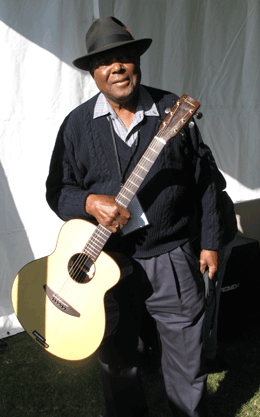 |
|
“Bowling Green” John Cephas. Photo by Rick Landers. |
JC: We got so many traditional artists that are practicing Piedmont Blues that there are a lot of accomplished Piedmont blues players. To come to mind we have a young Jeff Scott and there are a number of young people who are pursuing this music. I know Jeff is an up and coming player and a man of good character who has perfected his skill. As a matter of fact, I have a protégé that we are going to present today, Marc Pessar, from Virginia Beach. I teach across the country. I’ve been teaching him for about the last three years and we’ll have a chance to see him today.
What involvement do you have in today’s National Folk Festival?
JC: Besides playing I’m on the Executive Committee for the National Council for the Traditional Arts. This is a volunteer position and is a part of my effort to support the traditional arts, whether it’s the blues or any other form. Being a board member gives me an opportunity to aid and assist and to participate in the perpetuation of the traditional arts.
Related Links
Cephas and Wiggins
Baden Guitars
DC Blues Society
National Council for the Traditional Arts
Michael G. Stewart Photography
More articles by Rick Landers